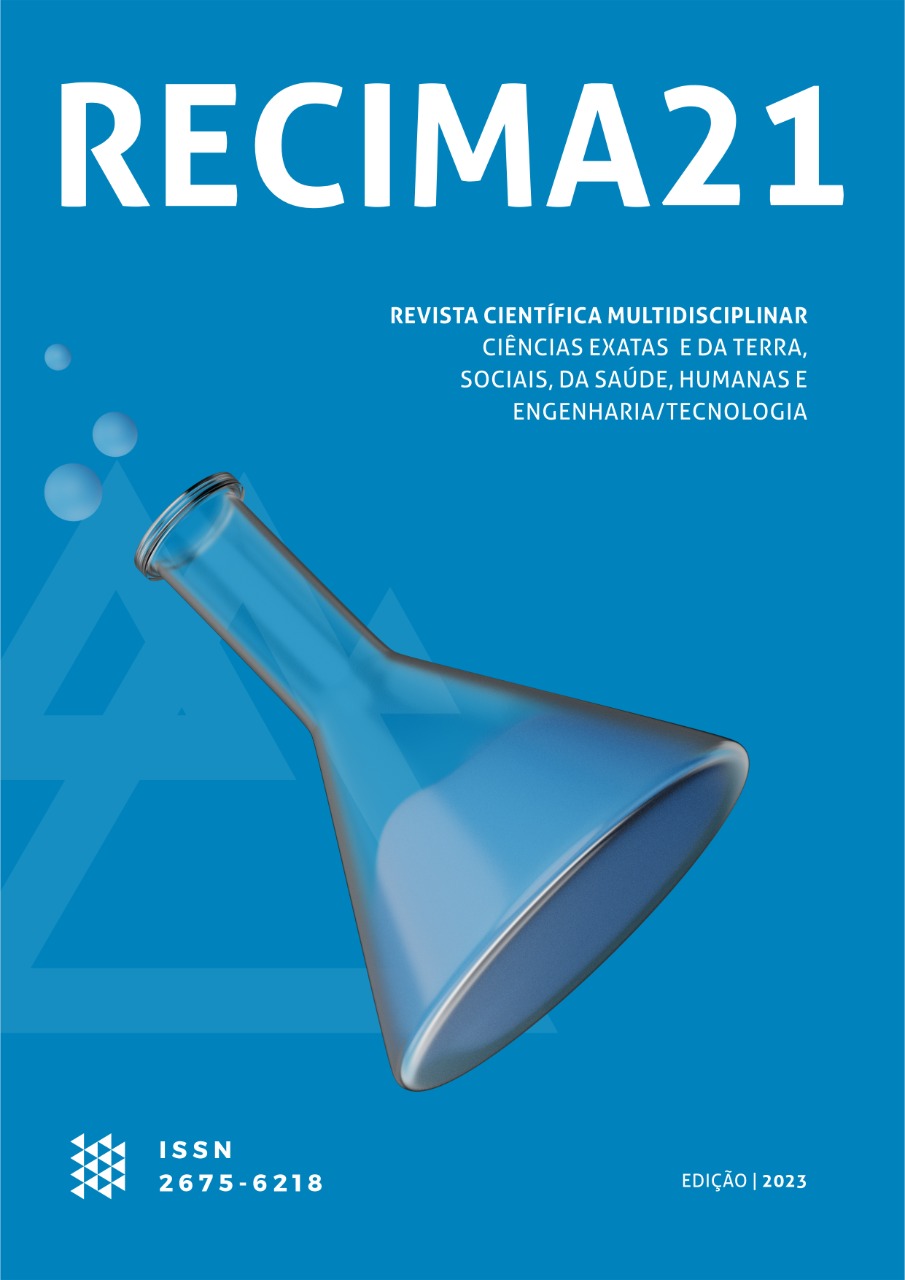IMPORTANCE OF THE CORRECT ASSOCIATION OF CLINICAL, IMAGINOLOGICAL AND HISTOPATHOLOGICAL EXAMS IN THE DIAGNOSIS OF OSTEOSARCOMA
DOI:
https://doi.org/10.47820/recima21.v4i2.2702Palavras-chave:
Radiografia panorâmica, osteossarcoma, TomografiaResumo
Osteosarcoma, a malignant neoplasm characterized by the production of osteoid tissue and immature bone that proliferates through the cellular stroma, is a rare disease of high aggressiveness associated with severe conditions of morbidity and mortality. Regarding the craniofacial region, osteosarcomas belong to less than 1% of all malignant neoplasms, with the mandible being the main affected bone. In the diagnostic process there is similarity with benign lesions, which requires detailed clinical analysis and complementary tests for definitive diagnosis. Treatment is based on radical surgical removal of the lesion with safety margins, associated or not with radiotherapy and/or chemotherapy. Head and neck osteosarcomas normally affect individuals between the third and fourth decade of life, with higher prevalence for females. This study aims to clarify the methods used for the diagnosis, treatment and follow-up of a patient with osteosarcoma in the mandible. Case report: A 35-year-old female patient attended the Center for Stomatology and Patients with Systemic Alterations (CEPAS) complaining of intermittent pain, tooth mobility with purulent secretion and facial asymmetry. The diagnosis process consisted of clinical, radiographic, tomographic and histopathological examinations, in a transdisciplinary approach. Partial mandibulectomy, chemotherapy and radiotherapy were performed as treatment. Conclusions: This study envisions the discussion of the complexity of diagnosis and prognosis of patients with osteosarcoma, as well as the need for humanized action of health teams, to provide patient care without focusing so on the disease.
Downloads
Referências
Valente R, Abreu TC, REAL FH. Osteosarcoma in the Mandible-Case report. Revista de Cirurgia e Traumatologia Buco-Maxilo-Facial. 2011. Out/Dez 11(4): 37-42.
Araujo JP. Estudo epidemiológico, clínico e imaginológico das lesões ósseas dos maxilares. 2015. 70 f. Dissertação (Mestrado) - Programa de Pós-Graduação em Odontologia, Universidade de São Paulo, São Paulo, 2015.
Alqahtani D; Alsheddi M; Al-Sadhan R. Epithelioid Osteosarcoma of the Maxilla. International Journal Of Surgical Pathology 2015. Jun 23(6): 495-499.
Tran LM., Mark R, Meier R, Calcaterra TC., Parker RG. Sarcomas of the head and neck. Prognostic factors and treatment strategies. Cancer.1992.Jul. 70(1):169-177.
Lukschal LF, Barbos RMLB, Alvarenga RL; Horta MCR. Osteossarcoma em maxila: relato de caso. Revista Portuguesa de Estomatologia, Medicina Dentária e Cirurgia Maxilofacial. 2013.Jan.54(1): 48-52.
Chindia ML, Guthua SW, Awange DO, Wakoli KA. Osteosarcoma of the maxillofacial bones in Kenyans J Maxillofac Surg 2002. 26 (2): 98-101.
Olavez D, Florido R, Padrón K, Omaña C, Solózano E. Maxillary osteosarcoma. Histopathologic case report. Acta bioclínica.2012. 2(3): 14-25.
Lee YY, Tassel PV, Nauert C, Raymond AK, Edeiken J. Craniofacial osteosarcoma-plain film ct, and mr findings in 46 cases. American jornal of neuroradiology. 1988. (9): 379-385.
Tossato OS, Pereira AC, Cavalcanti MPG. Osteossarcoma e condrossarcoma: diferenciação radiográfica por meio da tomografia computadorizada. Pesquisa Odontológica Brasileira. 2002. Mar.16(1): 69-76.
Cavalcanti MGP, Ruprecht A, Quest J. Evaluation of maxillofacial fibrosarcoma using computer graphics and spiral computed tomography. Dentomaxillofac Radiol. 1999.Mai.28(3):145-151.
Chrcanovic BR, Sousa, LN. A importância do diagnóstico diferencial entre o osteossarcoma de baixo grau e a displasia fibrosa – Revisão de literatura. Arquivo Brasileiro de Odontologia. 2012. 8(2): 55-62.
Caubi AF, Xavier RLF, Lima Filho MA, Chalegre JF. Bópsia. Revista de Cirurgia e Traumatologia Buco-Maxilo-Facial. 2004. Jan/Mar.4(1): 39-46.
Takahama Júnior A, Alves FA, Pinto CAL, Carvalho AL, Kowalski LP, Lopes MA. Clinicopathological and immunohistochemical analysis of twenty-five head and neck osteosarcomas Oral Oncol 2003; 39(5): 521-30
Mardinger O, Givol N, Talmi Y.P, Taicher S, Saba K. Osteosarcoma of the jaw Oral Med Oral Pathol Oral Radiol Endod 2001; 91: 445-51
Bennet J.H, Thomas G, Evans A.W, Speight PM. Osteosarcoma of the jaws: A 30-year retrospective review. Oral Surg Oral Med Oral Pathol 2000; 90(3): 323-33.
Soares RC, Soares AF, Souza LB, Santos ALV, Pinto LP. Osteossarcoma de mandíbula inicialmente mimetizando lesão do periápice dental: relato de caso. Revista Brasileira de Otorrinolaringologia.2005. Abr; 71(2):242-245.
Angel EE; Gava NF. Tumores Ósseos: Princípios de Diagnóstico e Tratamento. Ribeirão Preto. USP: S.I., 2012. 29.
Ribeiro ALR, Nobre RM, Alves Junior SMA, Silva e Souza PAR; Silva Junior NGS, Pinheiro JJV. The importance of early diagnosis and an accurate tumoral evaluation in the treatment of mandibular osteossarcoma. Rev. Odonto Ciênc. 2010;Jun; 25(3):319-324.
Nakayama E, Sugiura K, Kobayashi I, Oobu Ki, Ishibashi H, Kanda S. The association between the computed tomography findings, histologic features, and outcome of osteosarcoma of the jaw. Journal Of Oral And Maxillofacial Surgery.2005.Mar;63(3):311-318.
Ng SY, Songra A, Ali N, Carter JLB. Ultrasound features of osteosarcoma of the mandible—a first report. Oral Surgery, Oral Medicine, Oral Pathology, Oral Radiology, And Endodontology,2001. Nov; 92(5): 582-586.
Loureiro BMC, Altemani JMC, Reis F, Altemani AMAM. Osteossarcoma crâniofacial: um enfoque imagenológico. Revista Brasileira de Odontologia. 2017.Jun.74(2):176, 29.
Castro HC, Ribeiro KCB, Bruneira P. Osteossarcoma: experiência do serviço de oncologia pediátrica da Santa Casa de Misericórdia de São Paulo. Revista Brasileira de Ortopedia. 2008.Abr; 43(4):108-115.
Rosenthal MA, Mougos S, Wiesenfeld D. High-grade maxillofacial osteosarcoma: evolving strategies for a curable cancer. Oral Oncology.2003.Jun;39(4):402-404.
Downloads
Publicado
Edição
Seção
Categorias
Licença
Copyright (c) 2023 RECIMA21 - Revista Científica Multidisciplinar - ISSN 2675-6218

Este trabalho está licenciado sob uma licença Creative Commons Attribution 4.0 International License.
Os direitos autorais dos artigos/resenhas/TCCs publicados pertecem à revista RECIMA21, e seguem o padrão Creative Commons (CC BY 4.0), permitindo a cópia ou reprodução, desde que cite a fonte e respeite os direitos dos autores e contenham menção aos mesmos nos créditos. Toda e qualquer obra publicada na revista, seu conteúdo é de responsabilidade dos autores, cabendo a RECIMA21 apenas ser o veículo de divulgação, seguindo os padrões nacionais e internacionais de publicação.













